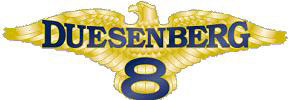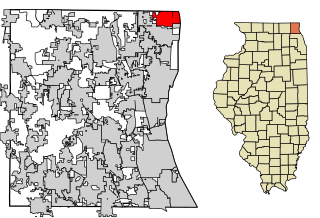
The Ford Model T is an automobile produced by Ford Motor Company from October 1, 1908, to May 26, 1927. It is generally regarded as the first affordable automobile, the car that opened travel to the common middle-class American; some of this was because of Ford's efficient fabrication, including assembly line production instead of individual hand crafting.

Packard was an American luxury automobile marque built by the Packard Motor Car Company of Detroit, Michigan, United States. The first Packard automobiles were produced in 1899, and the last Detroit-built Packard in 1956, when they built the Packard Predictor, their last concept car.
The Locomobile Company of America was a pioneering American automobile manufacturer founded in 1899, and known for its dedication to precision in the pre-assembly-line era. It was one of the earliest car manufacturers in the advent of the automobile age. For the first two years after its founding, the company was located in Watertown, Massachusetts. Production was transferred to Bridgeport, Connecticut, in 1900, where it remained until the company's demise in 1929. The company manufactured affordable, small steam cars until 1903, when production switched entirely to internal combustion-powered luxury automobiles. Locomobile was taken over in 1922 by Durant Motors and eventually went out of business in 1929. All cars ever produced by the original company were always sold under the brand name Locomobile.

Nash Motors Company was an American automobile manufacturer based in Kenosha, Wisconsin, in the United States from 1916 to 1937. From 1937 to 1954, Nash Motors was the automotive division of the Nash-Kelvinator Corporation. Nash production continued from 1954 to 1957 after the creation of American Motors Corporation.
The Ace was an American-assembled car made in Ypsilanti, Michigan by the Apex Motor Car Company, which was reorganized as the Apex Motor Corporation in 1921. The initial batch of cars assembled were sent to Seattle, Washington dealer FE Earnest, who had the idea for the Ace after he was unable to secure a steady supply of new cars for his dealership.

See also: Ajax - Swiss car; Ajax - French car; or Ajax - American car.

The American was an American automobile, built in Plainfield, New Jersey, manufactured from 1917 to 1924. The company also used names American Balanced Six or American Six, "Balanced" referred to its chassis, not the engine. It was an assembled car, one of many built in its time, and it used components from several manufacturers like Borg & Beck for clutch, Warner transmission, Stromberg carburetor and Rutenber engines.

Duesenberg Motors Company was an American manufacturer of race cars and luxury automobiles. It was founded by brothers August and Frederick Duesenberg in 1913 in Saint Paul, Minnesota, where they built engines and race cars. The brothers moved their operations to Elizabeth, New Jersey, in 1916 to manufacture engines for World War I. In 1919, when their government contracts were cancelled, they moved to Indianapolis, Indiana, home of the Indianapolis Motor Speedway, and established the Duesenberg Automobile and Motors Company, Inc. (Delaware). In late 1926, E.L. Cord added Duesenberg to his Auburn Automobile Company. With the market for expensive luxury cars severely undercut by the Great Depression, Duesenberg folded in 1937.

The Ford Model C is an automobile that was produced by Ford Motor Company. Introduced in 1904, it was a revision of the Model A with a more modern appearance. It had a slightly more powerful engine and 6 in (150 mm) longer wheelbase. Built at the Ford Piquette Avenue Plant, it was the entry-level car in the Ford model lineup, slotting below the upscale Model B. Production ended in 1905 with 800 cars made; it was replaced by the derivative Model F.

Singer Motors Limited was a British motor vehicle manufacturing business, originally a bicycle manufacturer founded as Singer & Co by George Singer, in 1874 in Coventry, England. Singer & Co's bicycle manufacture continued. From 1901 George Singer's Singer Motor Co made cars and commercial vehicles.

The Star was an automobile marque that was assembled by the Durant Motors Company between 1922 and 1928. Also known as the Star Car, Star was envisioned as a competitor against the Ford Model T.

Stevens-Duryea was an American manufacturer of automobiles in Chicopee Falls, Massachusetts, between 1901 and 1915 and from 1919 to 1927.

The early history of the automobile can be divided into a number of eras, based on the prevalent means of propulsion. Later periods were defined by trends in exterior styling, size, and utility preferences.

Daimler Motoren Gesellschaft (DMG) was a German engineering company and later automobile manufacturer, in operation from 1890 until 1926. Founded by Gottlieb Daimler and Wilhelm Maybach, it was based first in Cannstatt. Daimler died in 1900, and their business moved in 1903 to Stuttgart-Untertürkheim after the original factory was destroyed by fire, and again to Berlin in 1922. Other factories were located in Marienfelde and Sindelfingen.

Scripps-Booth was a United States automobile company based in Detroit, Michigan, which produced motor vehicles from 1913 through 1923.

Daniels Motor Company was a pioneer brass era American automobile company, founded in 1915 by George E. Daniels with Neff E. Paris.George Daniels was a known lawyer, engineer, and mechanic. He was considered the best motorcar designer in the United States. Neff Paris had his own automobile parts and framing manufacturing company. Neff was the creator of the time's highest-grade heat-treated alloy steel frames, respected in the steel industry. Daniels Motor Company produced 1,500 high quality automobiles between 1916-1924, branding themselves as “the distinguished car with just a little more power than you will ever need”, and “The aristocrat of American cars”.

The Jackson Automobile Company was an American Brass Era automobile manufacturer located in and named for Jackson, Michigan. The company produced the Jackson from 1903 to 1923, as well as the 1903 Jaxon steam car and the 1904 Orlo.

Mitchell-Lewis Motor Company was founded in 1900 in Racine, Wisconsin as a motorcycle maker spin-off from the wagon maker Mitchell & Lewis Company Ltd. The company began manufacturing automobiles in 1903. The wagon business and auto companies were combined into Mitchell-Lewis Motor Co. in 1910. The Mitchell car brand produced automobiles from 1903 to 1923.

Willys was a brand name used by Willys–Overland Motors, an American automobile company best known for its design and production of military Jeeps (MBs) and civilian versions (CJs) during the 20th century.

The Peugeot Type 156 was a large car announced in 1920 and produced between 1921 and 1923 by the French auto-maker Peugeot at their Sochaux plant. It was Peugeot’s first large car since before the First World War and its arrival recalled the Peugeot Type 135 which had ceased production in 1913. However, the 156 was larger and more powerful.





















